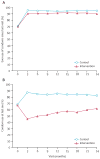Diaphragm and lubricant gel for prevention of HIV acquisition in southern African women: a randomised controlled trial
- PMID: 17631387
- PMCID: PMC2442038
- DOI: 10.1016/S0140-6736(07)60950-7
Diaphragm and lubricant gel for prevention of HIV acquisition in southern African women: a randomised controlled trial
Abstract
Background: Female-controlled methods of HIV prevention are urgently needed. We assessed the effect of provision of latex diaphragm, lubricant gel, and condoms (intervention), compared with condoms alone (control) on HIV seroincidence in women in South Africa and Zimbabwe.
Methods: We did an open-label, randomised controlled trial in HIV-negative, sexually active women recruited from clinics and community-based organisations, who were followed up quarterly for 12-24 months (median 21 months). All participants received an HIV prevention package consisting of pre-test and post-test counselling about HIV and sexually transmitted infections, testing, treatment of curable sexually transmitted infections, and intensive risk-reduction counselling. The primary outcome was incident HIV infection. This study is registered with ClinicalTrials.gov, number NCT00121459.
Findings: Overall HIV incidence was 4.0% per 100 woman-years: 4.1% in the intervention group (n=2472) and 3.9% in the control group (n=2476), corresponding to a relative hazard of 1.05 (95% CI 0.84-1.32, intention-to-treat analysis). The proportion of women using condoms was significantly lower in the intervention than in the control group (54%vs 85% of visits, p<0.0001). The proportions of participants who reported adverse events (60% [1523] vs 61% [1529]) and serious adverse events (5% [130] vs 4% [101]) were similar between the two groups.
Interpretation: We observed no added protective benefit against HIV infection when the diaphragm and lubricant gel were provided in addition to condoms and a comprehensive HIV prevention package. Our observation that lower condom use in women provided with diaphragms did not result in increased infection merits further research. Although the intervention seemed safe, our findings do not support addition of the diaphragm to current HIV prevention strategies.
Conflict of interest statement
Conflict of interest statement
We declare that we have no conflict of interest.
Figures



Comment in
-
Randomised trials of HIV prevention.Lancet. 2007 Jul 21;370(9583):200-201. doi: 10.1016/S0140-6736(07)61058-7. Lancet. 2007. PMID: 17631388 No abstract available.
-
Diaphragms and lubricant gel for prevention of HIV.Lancet. 2007 Dec 1;370(9602):1823; author reply 1823-4. doi: 10.1016/S0140-6736(07)61765-6. Lancet. 2007. PMID: 18061046 No abstract available.
-
Diaphragms and lubricant gel for prevention of HIV.Lancet. 2007 Dec 1;370(9602):1823; author reply 1823-4. doi: 10.1016/S0140-6736(07)61764-4. Lancet. 2007. PMID: 18061048 Free PMC article. No abstract available.
-
HIV prevention: why what should work sometimes doesn't.Curr Infect Dis Rep. 2008 May;10(2):119-20. doi: 10.1007/s11908-008-0021-z. Curr Infect Dis Rep. 2008. PMID: 18462585 No abstract available.
References
-
- UNAIDS/WHO. AIDS epidemic update: December 2006. Geneva: UNAIDS/WHO; 2006.
-
- WHO. HIV/AIDS epidemiological surveillance report for the WHO African Region: 2005 Update. Harare: WHO; 2005.
-
- Heise LL, Elias C. Transforming aids prevention to meet women’s needs: a focus on developing countries. Soc Sci Med. 1995;40:931–43. - PubMed
-
- d’Cruz-Grote D. Prevention of HIV infection in developing countries. Lancet. 1996;348:1071–74. - PubMed
-
- Green G, Pool R, Harrison S, et al. Female control of sexuality: illusion or reality? Use of vaginal products in south west Uganda. Soc Sci Med. 2001;52:585–98. - PubMed
Publication types
MeSH terms
Substances
Associated data
Grants and funding
LinkOut - more resources
Full Text Sources
Other Literature Sources
Medical

